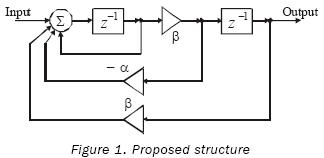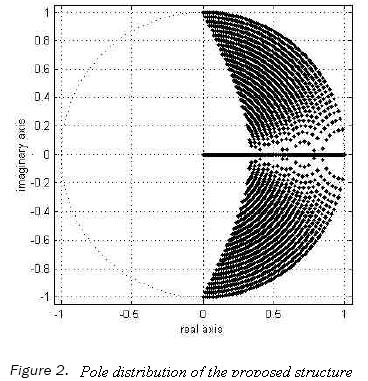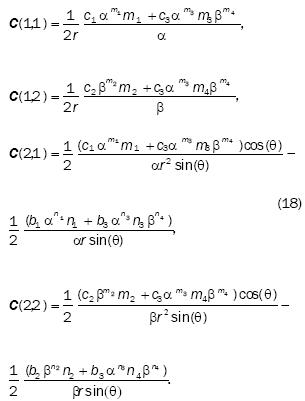Serviços Personalizados
Journal
Artigo
Indicadores
-
 Citado por SciELO
Citado por SciELO -
 Acessos
Acessos
Links relacionados
-
 Similares em
SciELO
Similares em
SciELO
Compartilhar
Ingeniería, investigación y tecnología
versão On-line ISSN 2594-0732versão impressa ISSN 1405-7743
Ing. invest. y tecnol. vol.9 no.1 Ciudad de México Jan./Mar. 2008
Estudios e investigaciones recientes
Symbolic sensitivity analysis of the new second–order IIR structure
Análisis simbólico sensitivo de la nueva estructura tipo IIR de segundo orden
G. Jovanovic–Dolecek1 and S.K. Mitra2
1 Institute INAOE, Department of Electronics, Tonantzintla, Puebla, Mexico
2 ECE Department, University of California, Santa Barbara, CA.
E–mails: gordana@inaoep.mx, mitra@ece.ucsb.edu
Recibido: noviembre de 2006
Aceptado: junio de 2007
Abstract
An high–order IIR (In fi nite im pulse response) filter is usually realized in the form of a cas cade or in the form of a parallel connection of second–order sections. Consequently, it is of in ter est to study properties of a second–order digital filter structures. To this end, in this paper we propose a new second–order IIR filter structure. The effect of multiplier coefficient quantization of the proposed structure is analyzed using the MATLAB–based symbolic analysis. The sensitivity matrix of the structure is computed in a symbolic form and its pole sensitivities are compared with that of other known structures.
Key words: IIR filter, second– order section, quantization, sensitivity analysis, sensitiv ty matrix, pole sensitivity.
Resumen
Los filtros digitales de alto orden con la respuesta al impulso infinita (IIR) se implementan normalmente en forma de cascada o en forma de una conexión paralela de segundo orden, respectivamente. Por tal motivo, hay un interés para investigar las características de las secciones de segundo orden. En este artículo se propone una nueva estructura IIR de segundo orden. Los efectos de la cuantizacion de los coeficientes de la estructura propuesta son hechos utilizando herramienta simbólica de MATLAB. La matriz de la sensitividad de la estructura se obtiene de una forma simbólica y sus polos sensitivos son comparados con otras estructuras conocidas.
Descriptores: Filtro IIR, sección del orden dos, cuantización, análisis de sensitividad, matriz de la sensitividad, sensitividad de los polos.
Introduction
The main effect of multiplier coefficient quantization on Infinite Impulse Response (IIR) digital filters is to move the poles and zeros to different locations from their original locations. As a result, the actual frequency response is different from the desired frequency response and may not be acceptable to the user (Mitra, 2006). Since the poles of the transfer function are more critical in determining the frequency response of the filter, we restrict our attention only to the movement of poles caused by quantization. If a pole remains close to the original location after coefficient quantization, the structure exhibits low pole sensitivity. Otherwise, the structure is expected to exhibit high pole sensitivity.
Additionally, a higher–order IIR filter is usually realized in the form of a cascade of second–order sections or in the form of a parallel connection of second orders sections. To this end, a low pole sensitivity of a high order IIR filter can be obtained by combining second order sections with low pole sensitivities.
Consider a second–order IIR filter transfer function

where the denominator polynomial is given by

and b and c are positive constants.
The poles of H(z) of equation (1) are at

where r is radius and 9 is the angle. Consequently,

Small changes of the coefficients b and c, by the amounts Δb and Δc respectively, result in a new denominator polynomial

The corresponding poles are at

Using equations (4)–(6) we relate the changes of the pole radius and angle with the changes of the coefficients b and c as

where (Mitra, 2006)

We consider here digital filter structures with two distinct multiplier coefficients a and p. The most general form of the functional dependence of the constants b and c on a and p is given by:

From equation (9) we have

Using Equations (7) and(10) we arrive at

where C is the sensitivity matrix.
In order to compare the sensitivities of different structures we need a quantitative sensitivity measure. To this end, we use here the upper limit of the variations of Δr and Δθ in the pole radius and angle, respectively, for a given change in the multiplier values, Δα and Aβ. The upper limit of variation of a function ΔF can be estimated by the worst–case method as (Lutovac & Tosic, 2001)

where SFxi is the sensitivity of F to the parameter xi. Applying equation (11) to equation (12) we have

Finally, it follows

or

The rest of the paper is organized in the following manner. The new structure is proposed in the next section, followed by the derivation of the symbolic sensitivity matrix of the proposed structure. Finally, the pole sensitivities of the proposed structure are compared with that of other known structures.
Proposed structure
We propose a new structure, containing 3 multipliers as shown in figure 1.

Its transfer function is given by

The pole distributions of the (16) using N=5 number of bits to represent the multiplier values, is given in figure 2. The figure shows the poles for each value of α and β, and –1< α, β<1, for which the coefficients fulfill the requirements of stability


Figure 2 indicates that there is a low sensitivity in the bandpass region. We use the sensitivity analysis described in Jovanovic Dolecek & Mitra (2006), to investigate in more details the sensitivity characteristics of the proposed structure.
General symbolic sensitivity matrix
In this section we use the result from Jovanovic Dolecek & Mitra (2006), to get the elements of the general sensitivity matrix C from equation (11) in the form

Next, the sensitivity matrix of the given structure is evaluated in two steps:
First, the symbolic coefficients in equations (18)

are replaced with the actual values of these coefficients obtained from the transfer function of the proposed structure using the MATLAB command

Next, the symbolic values of the multiplier coefficients α and β are replaced with their actual expressions as functions of the radius r and the angle 9 of the poles using the MATLAB command

Comparing the denominator of equation (16) with the general form given by equation (9) we have the following actual values of the symbolic coefficients (19):

Additionally it follows from equations (2), (9) and (16) :

In that way we get the symbolic sensitivity matrix of the proposed structure:

From equations (18) and (27) we have

In a similar way we find the diagrams (25) for some known structures used in the next section.
Discussion
The sensitivity diagrams (25) for the proposed structure are plotted in figure 3 (a) for values of the pole radius in the range [0.8 – 0.99], and the phase values in the range [p/4 – p/2]. In order to compare the sensitivity of the proposed structure we find the sensitivities diagrams of some well known structures, using the same values of pole radius and the same phase values, and the method described in Jovanovic Dolecek & Mitra (2006). The corresponding sensitivity diagrams are shown in figure 3 (b)–(f). The results are summarized in the table 1.
Conclusions
The main effect of multiplier coefficient quantization on IIR digital filters is to move the poles and zeros to different locations from their original locations. As a result, the actual frequency response is different from the desired frequency response. Since the poles of the transfer function are more critical in determining the frequency response of the filter, we restricted our attention only to the movement of poles caused by quantization.
We proposed a new second order structure with three multipliers. The analysis of the effects of quantization on the structure is done using the MATLAB–based symbolic toolbox. We derived the sym– bolic sensitivity matrix of the proposed structure. Using the symbolic matrices we plotted the sensitivity diagrams to compare the sensitivity characteristics of the proposed and some known structures. The analysis demonstrates that the proposed structure has a low sensitivity for values of the pole radius in the range [0.8 – 0.99], and the phase values in the range [p/4 – p/2].
Acknowledgement
This work was supported by a CONACYT grant 49640.
References
Gold B. and Rader C.M. Effects of parameter quantization on the poles of digital filter. Proc. IEEE, (May): 688–689. 1967. [ Links ]
Jovanovic D.G. and Mitra S.K. A new low sensitivity second–order bandpass digital filter structure. Electronics Letters, 38 (16):858–860. August 2002. [ Links ]
Jovanovic D.G. and Mitra S.K. Symbolic sensitivity analysis of IIR digital filters using MATLAB. International Journal of Control, 79 (11): 1331–1339. November 2006. [ Links ]
Kingsbury N. Second order recursive digital filter element for poles near the unit circle and the real z–axis. Electronics Letters, (March): 155–156, 1972. [ Links ]
Lutovac M., Tosic D. and Evans B. Filter Design for Signal Processing using MATLAB and MATHEMATICA, New Jersey. Prentice Hall. 2001. [ Links ]
Mitra S.K. Digital Signal Processing– A Computer Based Approach. (Third edition), New York. McGraw–Hill. 2006. [ Links ]
Yan G.T. and Mitra S.K. Modified coupled form digital–filter structures. Proc IEEE (Letters), 70: 762–763. July 1982. [ Links ]
Zölzer U. A low roundoff noise digital audio filter. In: Proc. Fifth European Signal Processing Conference (5ª, 1990, Barcelona, Spain). Eusipco 90, September 1990, pp.529– 532. [ Links ]
About the authors
Gordana Jovanovic–Dolecek. Received a BS degree, and a PhD degree from the Faculty of Electrical Engineering, University of Sarajevo. In 1995 she joined Institute INAOE, Department for Electronics, where she works as a professor and researcher. During 2001–2002 and 2006 she was at ECE Department of UCSB, Santa Barbara, as visiting researcher. She is the author of three books, editor of one book, and author of more than 200 papers. Her research interests include digital signal processing and digital communications. She is a member of Mexican Academy of Science, Senior member of IEEE and the member of SNI.
Sanjit K. Mitra. Received M.S. and Ph.D. degrees in Electrical Engineering from the UC Berkeley, in 1960 and 1962, respectively. He has been a Professor of Electrical and Computer Engineering at the UC Santa Barbara since 1977. He has published over 600 papers in signal and image processing, twelve books, and holds five patents. He is a member of the U.S. National Academy of Engineering, the Academy of Finland, the Norwegian Academy of Technological Sciences, the Croatian Academy of Sciences and Arts, and a member of the Academy of Engineering of Mexico. Dr. Mitra is a Fellow of the IEEE, AAAS, and SPIE, and a member of EURASIP.














